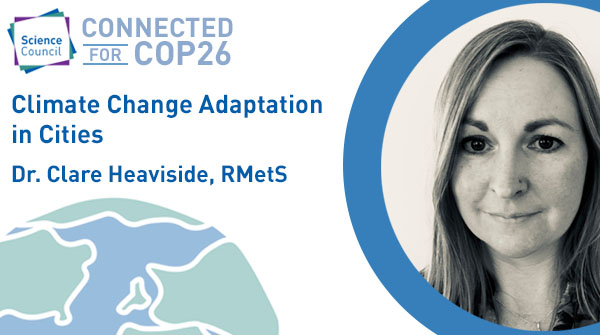
Connected for COP26: Climate Change Adaptation in Cities
Dr Clare Heaviside, NERC Independent Research Fellow and Associate Professor at UCL Institute for Environmental Design and Engineering on behalf of the Royal Meteorological Society.
Exposure to heat or even moderately high temperatures can lead to health conditions ranging from mild discomfort to serious illness, and is associated with an increased risk of death. Heat poses a particular health risk for elderly people, those working outdoors, and those with underlying health conditions.
Temperatures in cities are usually a few degrees higher than in the countryside, due to the urban heat island (UHI) effect, which is partly caused by a lack of moisture and vegetation in cities compared with rural areas, and because urban building materials store heat. This excess heat in cities, coupled with more frequent heatwaves as a result of climate change, means that urban populations (which currently make up more than 80% of the total UK population) are particularly at risk from overheating.
According to regional climate modelling for the period of the intense heatwave of August 2003, the highly urbanised West Midlands regions of the UK, which includes Birmingham, had an UHI intensity of 3oC on average, and a maximum of 7oC. We estimated that this excess heat associated with the UHI was responsible for around half of the 90 heat-related deaths associated with the heatwave period in this region. We also found that the UHI intensity was highest in parts of cities with higher levels of deprivation.
Adaptation measures designed to reduce urban heat in cities often fall into two categories: those which focus on increasing the amount of moisture through introducing vegetation (sometimes called ‘green infrastructure’) or water bodies; and those which are based on reflection of the incoming solar radiation.
Increasing urban green infrastructure can be achieved by installing green roofs and vertical green walls, or simply by replacing non-permeable surfaces with natural surfaces like grass. Street trees have the advantage of increasing shading, which can improve thermal comfort. As well as providing a method to cool the local environment and providing carbon storage, green space is known to have positive effects on mental health and wellbeing. Some considerations such as the need for maintenance and irrigation for certain types of green infrastructure means that some environments may be more suitable than others for these solutions.
Another way to decrease local temperatures is through increasing the reflectivity of urban surfaces such as roofs, walls and roads, so that sunlight is reflected before it heats up the urban fabric. One advantage of reflective roof surfaces, known as ‘cool’ roofs is that they can be cheap to install and maintain, and could be as simple as painting roof surfaces white. We ran our regional climate model with a modified simulation to see what the effect would be of implementing cool roofs on different categories of buildings (e.g. commercial, residential) on the local UHI intensity, again in the West Midlands. We found that cool roofs were particularly effective at reducing maximum daytime temperature, and when used on commercial building types, rather than residential buildings. The maximum daytime air temperature was reduced by around 0.5oC on average, and up to 3oC in the cool roof scenario. This reduction in temperature would be the equivalent of a decrease in the heat-related mortality associated with the UHI (‘deaths avoided’) of around 23%.
After estimating the extent to which the UHI affects heat mortality, we also modelled the winter season, and found that at this time of year, the UHI actually has a protective effect on health, by reducing cold-related mortality. Interestingly, our modelling also showed that cool roofs did not significantly diminish this protective effect in winter, when solar energy is lower. This suggests that cool roofs could have a net annual benefit in terms of reduced temperature-related mortality and could potentially provide a low-cost, sustainable solution for reducing the health impacts associated with urban overheating.
Read the rest of the blog series here.
